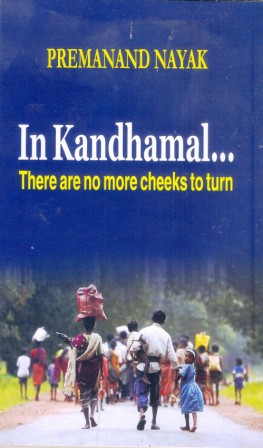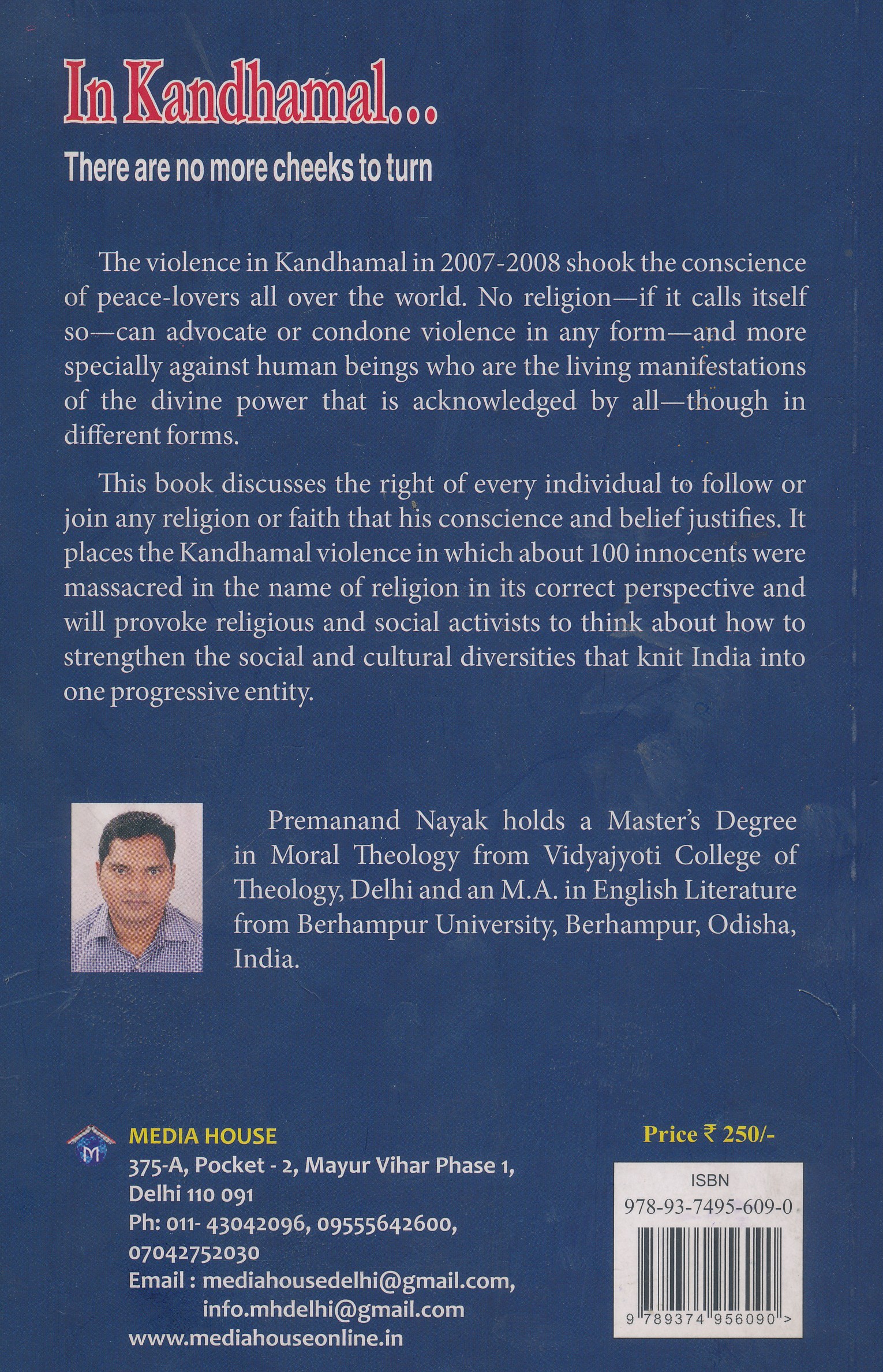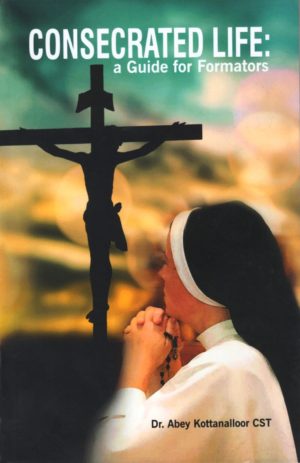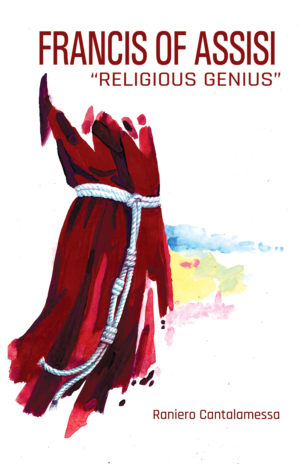Description
The violence in Kandhamal in 2007-2008 shook the conscience of peace-lovers all over the world. No religion—if it calls itself so—can advocate or condone violence in any form—and more specially against human beings who are the living manifestations of the divine power that is acknowledged by all—though in different forms.
This book discusses the right of every individual to follow or join any religion or faith that his conscience and belief justifies. It places the Kandhamal violence in which about 100 innocents were massacred in the name of religion in its correct perspective and will provoke religious and social activists to think about how to strengthen the social and cultural diversities that knit India into one progressive entity.
About the Author
Premanand nayak holds a Master’s Degree in Moral Theology from Vidyajyoti College of Theology , Delhi and an M.A. in english Literature from Berhampur University , Berhampur, Odisha, India
CONTENTS
Foreword
Acknowledgements
Abbreviations
Introduction
Chapter One
Social Teaching of the Church on Freedom of Religion
1.0. Introduction
1.1. Catholic Social Teaching
1.2. Principles of Catholic Social Teaching
1.2.1. The Principle of Respect for Human Dignity
1.2.1.1. Human Rights and Human Dignity.
1.2.1.2. The Right to Human Life and Human Dignity
1.2.2. The Principle of Common Good.
1.2.2.1. Common Good as a Fundamental Principle.
1.2.3. The Principle of Solidarity.
1.2.3.1. Solidarity as a Moral Virtue and Charity
1.2.3.2. Solidarity as One of the Central Concepts in CST
1.2.4. The Principle of Subsidiarity
1.2.5. The Principle of the Preferential Option for the Poor
1.2.5.1. Social Documents on the Preferential Option for the Poor
1.2.5.2. Option for the Poor as a Moral Concern.
1.2.6. The Principle of Social Justice.
1.2.6.1. Three Dimensions of Justice.
1.2.6.1.1. Commutative Justice..
1.2.6.1.2. Distributive Justice..
1.2.6.1.3. Social Justice.
1.3. The Concept of Freedom of Religion.
1.4. Social Teaching of the Church on Freedom of Religion
1.4.1. A Brief Historical Survey on Religious Freedom.
1.4.1.1. Pre-Constantine and Constantine Periods
1.4.1.2. Augustinian Period.48
1.4.1.5. The Enlightenment Period
1.4.1.6. Religious Freedom in Indian Tradition
1.4.2. Vatican II – Declaration of
Religious Freedom (Dignitatis Humanae)
1.4.2.1. Introduction to the Declaration of Religious Freedom
1.4.2.2. Some Aspects of the Discussion on
the Schema of the Declaration.
1.4.2.3. The Basic Perspectives of Dignitatis Humanae-.
An Analysis of the Articles.
1.4.2.4. Article 1: On the Right of the Person and Communities
to Social and Civil Liberty in Religious Matters
1.4.2.5. Articles 2-8: The General Principle of Religious Freedom…..59
1.4.2.6. Articles 9-15 : Religious Freedom in
the Light of Revelation
1.4.2.7. Concluding Remarks
1.4.3. Religious Freedom in the Post-Conciliar Magisterium.
1.4.3.1. EvangeliiNuntiandi (EN).
1.4.3.2. RedemptorHominis (EH).
1.4.3.3. RedemptorisMissio (KM).
1.4.3.4. Catechism of the Catholic Church..
1.4.3.5. Compendium of the Social Doctrine of the Church..
1.4.3.6. Thirtieth Anniversary of the Universal Declaration of Human Rights .
1.4.3.7. Pope John Paul II’s Address to
the Diplomatic Corps in Kenya
1.4.3.8. At the Colloquium The Church and Human Rights’
1.4.3.9. World Day of Peace (WDP 1991)
1.4.3.10. World Day of Peace (WDP 2011).
1.5. Conclusion.
Chapter Two
Right to Freedom of Religion as Envisaged in the Legal Framework of India
2.0. Introduction.
2.1. The Legal Framework in India on Freedom of Religion..
2.1.1. The Constitutional Framework..
2.1.1.1. Preamble to the Constitution of India..
2.1.1.2. Constitution of India and Freedom of Religion..
2.1.1.3. Other Laws of India.
2.1.1.4. Marital Laws.
2.1.1.5. Freedom of Religion Acts for Specific States of India.
2.1.1.5.1.Madhya Pradesh Dharma Swatantrya Adhiniyam (1967)
2.1.1.5.2. The Orissa Freedom of Religion Act 1967.
2.1.1.5.3. Arunachal Pradesh Freedom of Religion Act 1978.
2.1.1.5.4. Tamil Nadu Prohibition of Forcible Conversion Act 2002..
2.1.1.5.5. Gujarat Freedom of Religion Act 2003.
2.1.1.5.6. Rajasthan Dharma Swatantraya Act 2006.
2.2. The International Legal Framework
2.2.1. Universal Declaration of Human Rights.
2.2.2. International Covenant on Civil and Political Rights (ICCPR)..
2.2.3. Declaration on the Elimination of
All Forms of Intolerance and of Discrimination Based on Religion or Belief
National or Ethnic, Religious or Linguistic Minorities
2.3. Framework and Standards of State Accountability.
2.3.1. India as a State Party to International Conventions
2.3.2. The Obligation of the State to Protect and
Promote Fundamental and Human Rights.
2.3.2.1. Obligation to Respect
2.3.2.2. Obligation to Protect
2.3.2.3. Obligation to Fulfil
2.3.3. The Concept of Due Diligence is a Yardstick of
State Obligations
2.4. Conclusion.
Violation of the Right to Religious Freedom of the Christian Minority
3.0. Introduction.
3.1. Background and Context of the
Kandhamal Violence against Christians
3.1.1. Socio-Political Background of
the Christian Minority in Kandhamal.
3.1.2. The Presence of the Sangh Parivarin Odisha.
3.1.3. Swami Laxmanananda Saraswati – His Vision and Mission.
3.1.3.1. The Reconversion Programme of
Laxmanananda against Christians.0
3.1.4. An Ethnic Conflict Between Kandhas (Tribals)
and Panos (Dalits).
3.1.5. The Presence of Maoists in Kandhamal.
3.2. Anti-Christian Violence in Kandhamal.
1.4.1.3. The Medieval Period..
1.4.1.4. The Reformation Period..





Reviews
There are no reviews yet.